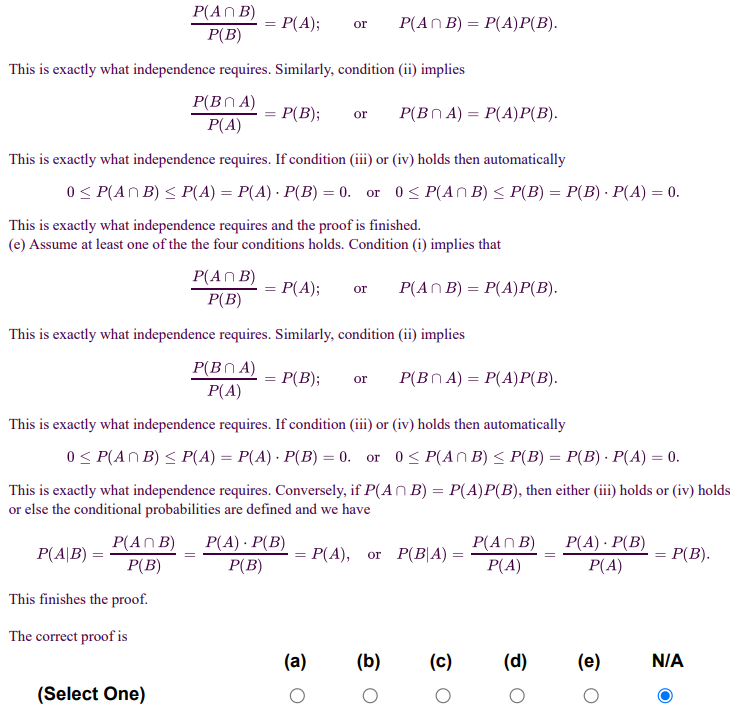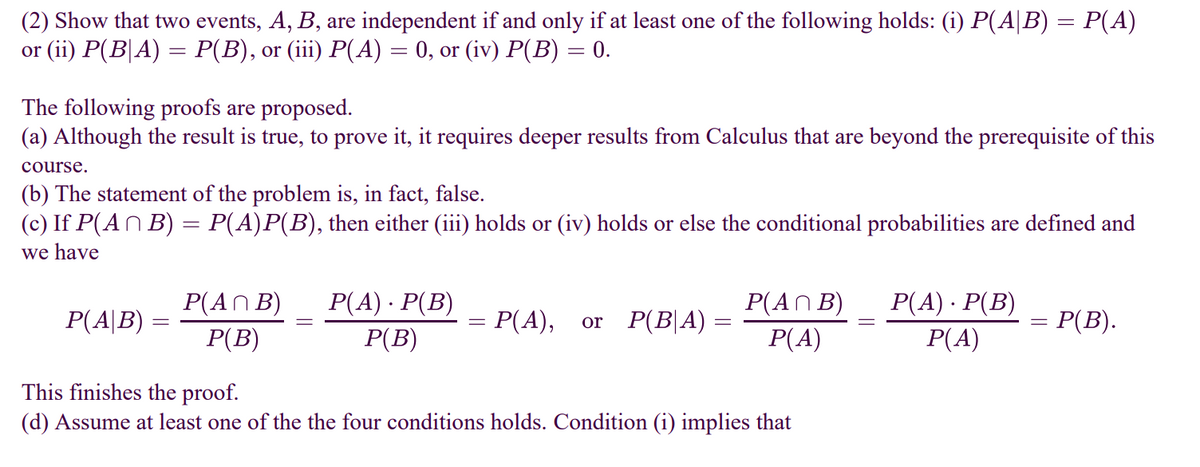P(A); P(AN B) = P(A)P(B). or P(B) This is exactly what independence requires. Similarly, condition (ii) implies P(BN A) P(A) P(B); or P(BN A) = P(A)P(B). This is exactly what independence requires. If condition (iii) or (iv) holds then automatically 0< ΡPAΠ Β) < P(4) P(4) . P(B)-0 or 0< PAn Β) < PB) - PB) . PA) =0. This is exactly what independence requires and the proof is finished. (e) Assume at least one of the the four conditions holds. Condition (i) implies that P(An B) = P(A); P(AN B) = P(A)P(B). or
P(A); P(AN B) = P(A)P(B). or P(B) This is exactly what independence requires. Similarly, condition (ii) implies P(BN A) P(A) P(B); or P(BN A) = P(A)P(B). This is exactly what independence requires. If condition (iii) or (iv) holds then automatically 0< ΡPAΠ Β) < P(4) P(4) . P(B)-0 or 0< PAn Β) < PB) - PB) . PA) =0. This is exactly what independence requires and the proof is finished. (e) Assume at least one of the the four conditions holds. Condition (i) implies that P(An B) = P(A); P(AN B) = P(A)P(B). or
Elementary Linear Algebra (MindTap Course List)
8th Edition
ISBN:9781305658004
Author:Ron Larson
Publisher:Ron Larson
Chapter2: Matrices
Section2.5: Markov Chain
Problem 16E: Consumer Preference In a population of 100,000 consumers, there are 20,000 users of Brand A, 30,000...
Related questions
Question

Transcribed Image Text:P(AN B)
P(B)
= P(A);
P(AN B) = P(A)P(B).
or
This is exactly what independence requires. Similarly, condition (ii) implies
P(Bn A)
= P(B);
P(Bn A) = P(A)P(B).
or
P(A)
This is exactly what independence requires. If condition (iii) or (iv) holds then automatically
0< PAn B)< PA)P(Α) - P(B) -0 or 0< P(Α Ω Β) < P(B) P(B).P(Α) 0.
This is exactly what independence requires and the proof is finished.
(e) Assume at least one of the the four conditions holds. Condition (i) implies that
P(An B)
P(B)
= P(A);
P(AN B) = P(A)P(B).
or
This is exactly what independence requires. Similarly, condition (ii) implies
P(BN A)
P(B);
P(BN A) = P(A)P(B).
or
P(A)
This is exactly what independence requires. If condition (iii) or (iv) holds then automatically
O< P(ANB) < P(A) = P(A) · P(B) = 0. or 0< P(An B) < P(B) = P(B) · P(A) = 0.
This is exactly what independence requires. Conversely, if P(An B) = P(A)P(B), then either (iii) holds or (iv) holds
or else the conditional probabilities are defined and we have
P(A) · P(B)
P(A) · P(B)
P(A)
P(An B)
P(An B)
P(A|B) =
P(B)
P(B)
= P(A), or P(B|A) =
P(A)
- Р(В).
This finishes the proof.
The correct proof is
(a)
(b)
(c)
(d)
(e)
N/A
(Select One)

Transcribed Image Text:(2) Show that two events, A, B, are independent if and only if at least one of the following holds: (i) P(A|B) = P(A)
or (ii) P(B|A) — Р(B), or (i) P(А) — 0, or (iv) P(в) — 0.
The following proofs are proposed.
(a) Although the result is true, to prove it, it requires deeper results from Calculus that are beyond the prerequisite of this
course.
(b) The statement of the problem is, in fact, false.
(c) If P(AN B) = P(A)P(B), then either (iii) holds or (iv) holds or else the conditional probabilities are defined and
we have
Р() - Р(В)
P(AN B)
Р(B)
P(A) · P(B)
Р(В)
P(AN B)
P(A)
P(A|B)
= P(A),
or P(B|A) =
= P(B).
P(A)
This finishes the proof.
(d) Assume at least one of the the four conditions holds. Condition (i) implies that
Expert Solution
This question has been solved!
Explore an expertly crafted, step-by-step solution for a thorough understanding of key concepts.
Step by step
Solved in 2 steps

Knowledge Booster
Learn more about
Need a deep-dive on the concept behind this application? Look no further. Learn more about this topic, probability and related others by exploring similar questions and additional content below.Recommended textbooks for you

Elementary Linear Algebra (MindTap Course List)
Algebra
ISBN:
9781305658004
Author:
Ron Larson
Publisher:
Cengage Learning

Holt Mcdougal Larson Pre-algebra: Student Edition…
Algebra
ISBN:
9780547587776
Author:
HOLT MCDOUGAL
Publisher:
HOLT MCDOUGAL

Algebra & Trigonometry with Analytic Geometry
Algebra
ISBN:
9781133382119
Author:
Swokowski
Publisher:
Cengage

Elementary Linear Algebra (MindTap Course List)
Algebra
ISBN:
9781305658004
Author:
Ron Larson
Publisher:
Cengage Learning

Holt Mcdougal Larson Pre-algebra: Student Edition…
Algebra
ISBN:
9780547587776
Author:
HOLT MCDOUGAL
Publisher:
HOLT MCDOUGAL

Algebra & Trigonometry with Analytic Geometry
Algebra
ISBN:
9781133382119
Author:
Swokowski
Publisher:
Cengage

College Algebra
Algebra
ISBN:
9781305115545
Author:
James Stewart, Lothar Redlin, Saleem Watson
Publisher:
Cengage Learning